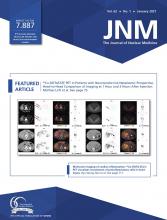Abstract
64Cu-DOTATATE PET/CT imaging 1 h after injection is excellent for lesion detection in patients with neuroendocrine neoplasms (NENs). We hypothesized that the imaging time window can be extended up to 3 h after injection without significant differences in the number of lesions detected. Methods: From a prospective study, we compared, on a head-to-head basis, sets of 64Cu-DOTATATE PET/CT images from 35 patients with NENs scanned 1 and 3 h after injection of 200 MBq of 64Cu-DOTATATE. The number of lesions on both PET scans was counted and grouped according to organs or regions and compared with negative binomial regression. Discordant lesions (visible on only the 1-h images or only the 3-h 64Cu-DOTATATE PET images) were considered true if found on simultaneous CT or later MR, CT, or somatostatin receptor imaging. We measured lesion SUVmax, reference normal-organ or -tissue SUVmean, and tumor–to–normal-tissue ratios calculated from SUVmax and SUVmean. Results: We found 822 concordant lesions (visible on both 1-h and 3-h 64Cu-DOTATATE PET) and 5 discordant lesions, of which 4 were considered true. One discordant case in 1 patient involved a discordant organ system (lymph node) detected on 3-h but not 1-h 64Cu-DOTATATE PET that did not alter the patient’s disease stage (stage IV) because the patient had 11 additional concordant liver lesions. We found no significant differences between the number of lesions detected on 1-h and 3-h 64Cu-DOTATATE PET. Throughout the 1- to 3-h imaging window, the mean tumor–to–normal-tissue ratio remained high in all key organs: liver (1 h: 12.6 [95% confidence interval (CI), 10.2–14.9]; 3 h: 11.0 [95%CI, 8.7–13.4]), intestines (1 h: 24.2 [95%CI, 14.9–33.4]; 3 h: 28.2 [95%CI, 16.5–40.0]), pancreas (1 h: 42.4 [95%CI, 12.3–72.5]; 3 h: 41.1 [95%CI, 8.7–73.4]), and bone (1 h: 103.0 [95%CI, 38.6–167.4]; 3 h: 124.2 [95%CI, 57.1–191.2]). Conclusion: The imaging time window of 64Cu-DOTATATE PET/CT for patients with NENs can be expanded from 1 h to 1–3 h without significant differences in the number of lesions detected.
Footnotes
Published online May 22, 2020.
- © 2021 by the Society of Nuclear Medicine and Molecular Imaging.







